Identifying Mobility Challenges in Birds
Recognising mobility issues in birds is crucial for their well-being. Birds often disguise their discomfort, making it vital to observe their behaviour carefully. Common signs of discomfort include limping, struggling to perch, or unsteady movements. These subtle cues are often the first indicators of mobility challenges, and addressing them early can enhance the bird’s quality of life.
Early detection plays a pivotal role in providing effective care. Birds, being prey animals, naturally hide weaknesses to avoid predators. As a result, owners may not notice problems until they are advanced. Regular health check-ups and keen observation can significantly aid in spotting changes in mobility. The sooner these changes are detected, the better the prospect of successful intervention and rehabilitation.
This might interest you : Designing a Secure and Enriching Outdoor Haven for Your Small Pets
Various tools and techniques are available to monitor a bird’s movements. Cameras can help record and assess movement patterns, while owners can also use interactive play sessions to observe their bird’s agility and energy levels. Further, consulting with avian veterinarians can provide insights into advanced diagnostics and treatment for specific mobility issues. This comprehensive approach ensures birds remain healthy and active, enhancing their overall well-being.
Practical Care Tips for Birds with Mobility Challenges
Providing the best bird care strategies for our feathered friends requires some adjustments, especially when dealing with mobility challenges. Understanding how to adapt daily care routines can make a profound difference in their quality of life.
Topic to read : Creating a Calm Oasis: Essential Tips for a Stress-Free Home for Your Rescue Cat
Firstly, adjusting routines is crucial. Start by ensuring that everything your bird needs, from food to favourite toys, is within reach. This eliminates unnecessary strain and encourages independence. Gradually train your bird to navigate these rearranged settings, fostering confidence and comfort.
Safe handling techniques are vital. When transporting, always support your bird’s body gently yet securely. You may use soft fabrics or towels to cradle your bird, reducing stress and the risk of injury. Always be mindful of your bird’s comfort and anxiety levels during these interactions.
Consider incorporating mobility assistance tools. There are a variety of assistive devices available, such as ramps or custom perches, which support movement and rest. These devices should be chosen based on your bird’s specific needs, ensuring they contribute to a balanced and stress-free environment.
Implementing these strategies can significantly enhance your bird’s daily experiences, fostering both physical and emotional well-being.
Housing Adaptations for Enhanced Comfort
Creating a harmonious environment for our feathered friends involves thoughtful bird housing modifications. Accessible habitats contribute significantly to their wellbeing. Consider spacious enclosures that allow birds to manoeuvre freely. Optimising perch placements can be crucial, as the right height and materials make a difference.
Guidelines for Designing Accessible Living Spaces
When designing an environment, ensure it mimics a bird’s natural habitat. Incorporate diverse vegetation and varied surfaces. This enriches the habitat and provides mental stimulation.
Essential Features to Include
Key elements in a bird enclosure include differing perch sizes to accommodate diverse grip strengths. Ensuring access to essential resources like food and water is paramount. Install feeding stations at various levels, catering to birds with varying mobility needs.
Safety Measures
Safety is a critical aspect of these accessible habitats. Utilise non-toxic materials throughout the enclosure to prevent accidental ingestion. Smooth, rounded edges on all installations minimise injury risk. A maintenance routine is vital to ensure no sharp or damaging elements are overlooked.
By embracing these housing adaptations, we not only meet basic housing needs but also contribute to a bird’s flourishing and comfort.
Dietary Considerations for Birds with Mobility Challenges
Birds with mobility issues benefit tremendously from nutrition tailored to their specific needs. A balanced diet is vital for supporting their mobility and overall health. As birds with these issues often have unique energy requirements, understanding the essential dietary adjustments can improve their quality of life.
First and foremost, providing healthy food options rich in nutrients is essential. Incorporate a variety of seeds, fruits, and vegetables that supply vitamins and minerals essential for muscle and bone strength. Foods such as leafy greens, carrots, and berries are excellent choices.
Dietary adjustments might include increasing protein intake to support muscle maintenance and boost energy levels. Opt for high-protein foods like cooked eggs or mealworms, which can help in revitalizing energy without burdening the metabolism.
Supplementary options like calcium supplements are beneficial for bone density, potentially aiding birds in regaining some mobility. Adding omega-3 fatty acids can also enhance the bird’s nutritional profile, promoting joint health and reducing inflammation.
Consistent monitoring of the bird’s diet and any changes in its condition is fundamental. Work closely with a veterinarian to ensure the bird’s dietary needs align with its health goals, ensuring the best possible outcome for your feathered friend.
Environmental Enrichment Strategies
Creating a stimulating environment for mobility-challenged birds is essential for their mental and physical well-being. Such environments can significantly enhance the bird’s quality of life by encouraging interaction and engagement with surroundings.
Types of Enrichment Activities
For birds with limited mobility, consider tailored bird enrichment activities that cater to their specific needs. Include simple puzzle feeders filled with food or treats, which encourage problem-solving and provide mental stimulation. Adjusting the height and accessibility of these so they can be easily reached is crucial. Rotate toys regularly to maintain interest and prevent boredom.
Recommended Toys and Activities
When selecting toys, opt for those that can offer diverse sensory experiences. Toys that jingle, crinkle, or are colourful can effectively stimulate the senses. Also, providing safe chew toys can keep birds occupied and help to maintain beak health.
Creating Interactive Spaces
Design interactive spaces by using various textures and materials that can be safely explored. This could include a variety of perches, from softer cloth-wrapped styles to harder natural wood types. Offering choices enhances control over their environment, which can support mental well-being significantly.
Resources for Veterinary Care
Understanding veterinary resources available for birds is crucial for maintaining their health and well-being. It is important to identify avian veterinarians who are not only equipped but also knowledgeable in specialized avian care. Such professionals can offer tailored advice and treatments necessary for your pet bird’s unique needs.
When to seek help from these veterinarians can vary. Instances include observing changes in behaviour, appetite, or droppings. Early intervention is vital; as birds often conceal illness to avoid showing weakness. By seeking veterinary advice promptly, potential health issues can be addressed effectively before they escalate.
Additionally, the rise of telehealth consultations offers a valuable resource for bird owners seeking advice from specialists without a physical visit. This service can guide immediate care steps and offer insights into whether an in-person consultation is necessary.
While face-to-face visits remain essential for thorough examinations and treatments, telehealth provides a timely means for initial assessments and quick queries. Ensuring your feathered friends have access to appropriate care involves understanding and utilizing these resources effectively. With the right veterinary resources, you can better safeguard your bird’s health.
Case Studies and Personal Experiences
Glean insights from bird care stories and real-life experiences to better understand the nuances of caring for birds, especially those with mobility challenges. Real-life examples allow us to see the practical application of bird care advice and the tangible impact it can have on both the birds and their caregivers. For instance, a success story could involve a parrot named Charlie that, despite wing damage, thrived through a practical regimen of tailored exercise and diet adjustments.
Bird caregivers have shared that patience and innovation are key factors in overcoming obstacles. Through trial and error, many have discovered resourceful solutions like custom perches or specific dietary plans that accommodate their bird’s unique needs.
Community resources and support networks, such as online forums and local bird clubs, play a crucial role in these journeys. They provide a platform for caregivers to share lessons learned, seek advice, and offer support. Within these communities, caregivers can find guidance and camaraderie, facilitating a smoother path towards successful bird rehabilitation.
By exploring these case studies and personal experiences, one gains deeper appreciation and understanding of the dedication required in this rewarding endeavor.
Visual Aids and Demonstrative Techniques
Visual aids play a crucial role in ensuring effective bird care. Instructional videos and visual guides provide bird enthusiasts with hands-on learning experiences, which can significantly enhance understanding. These resources show the correct techniques for activities like cage cleaning, feeding routines, and health checks, allowing viewers to see best practices in action.
When looking for how-to resources, opt for reputable platforms or creators who demonstrate a solid understanding of avian care. Look for signs of expertise, such as professional qualifications or partnerships with recognised bird care organisations. Reliable resources often come with positive reviews and community endorsements, ensuring that you learn from trusted sources.
If you decide to make your own visual guides, consider these filming tips:
- Ensure your video quality is high for clarity and focus.
- Speak clearly and explain each step in a straightforward manner.
- Use proper lighting to enhance visibility.
Finally, engage an audience by showing both successes and common mistakes to avoid, providing viewers with comprehensive learning experiences. By sharing your knowledge, you contribute to a community dedicated to the well-being of birds, encouraging others to adopt informed and careful practices.











